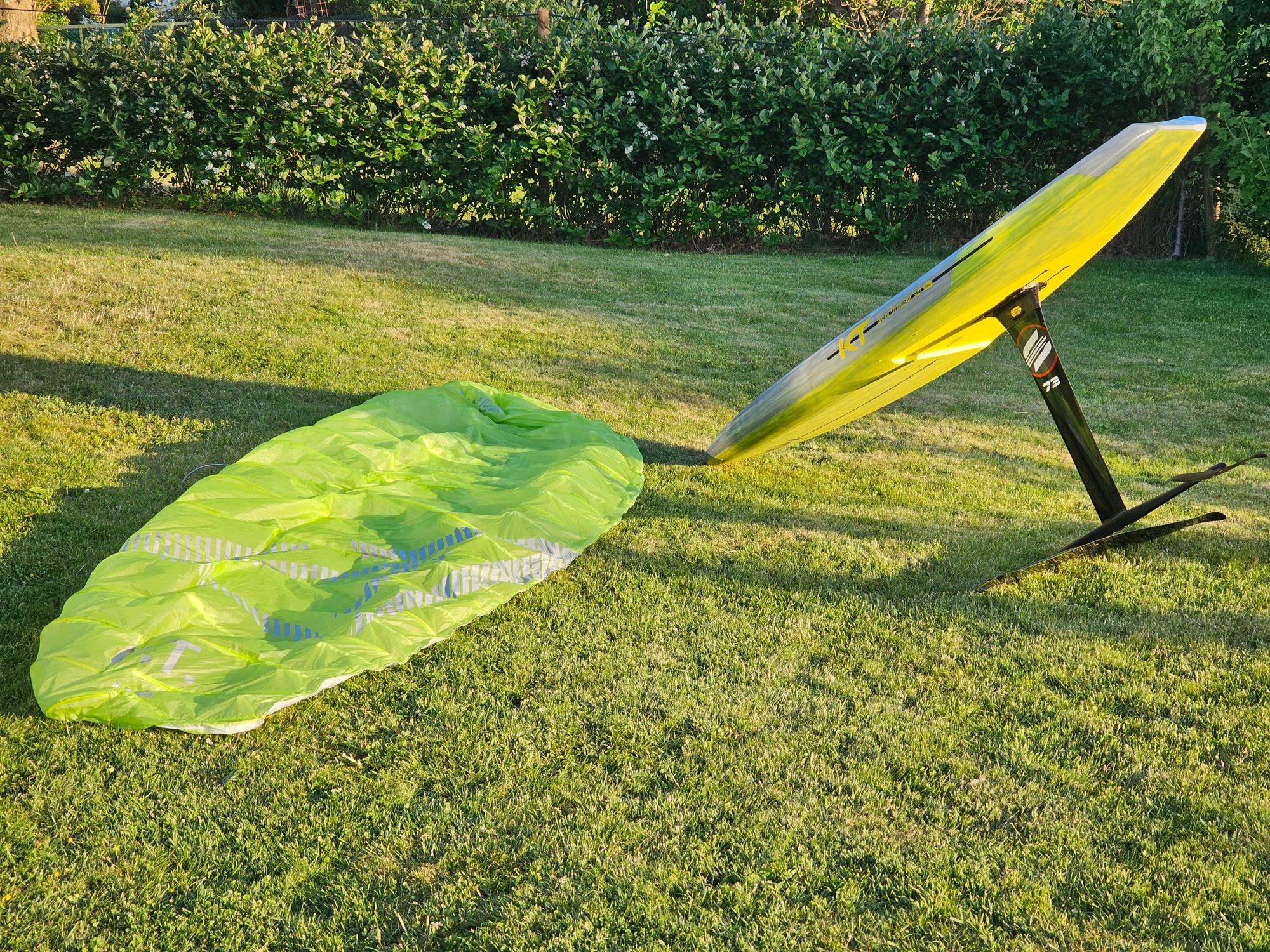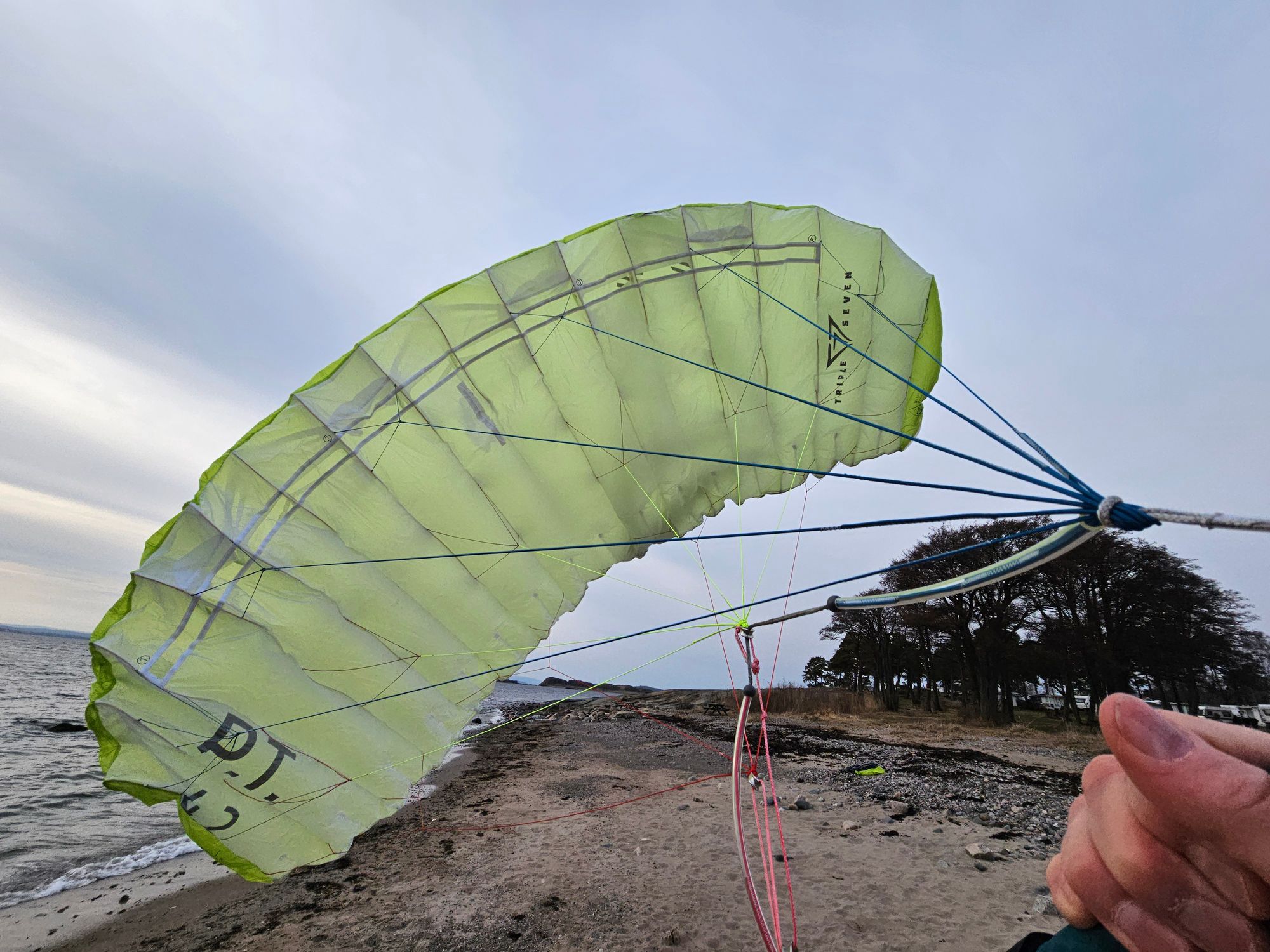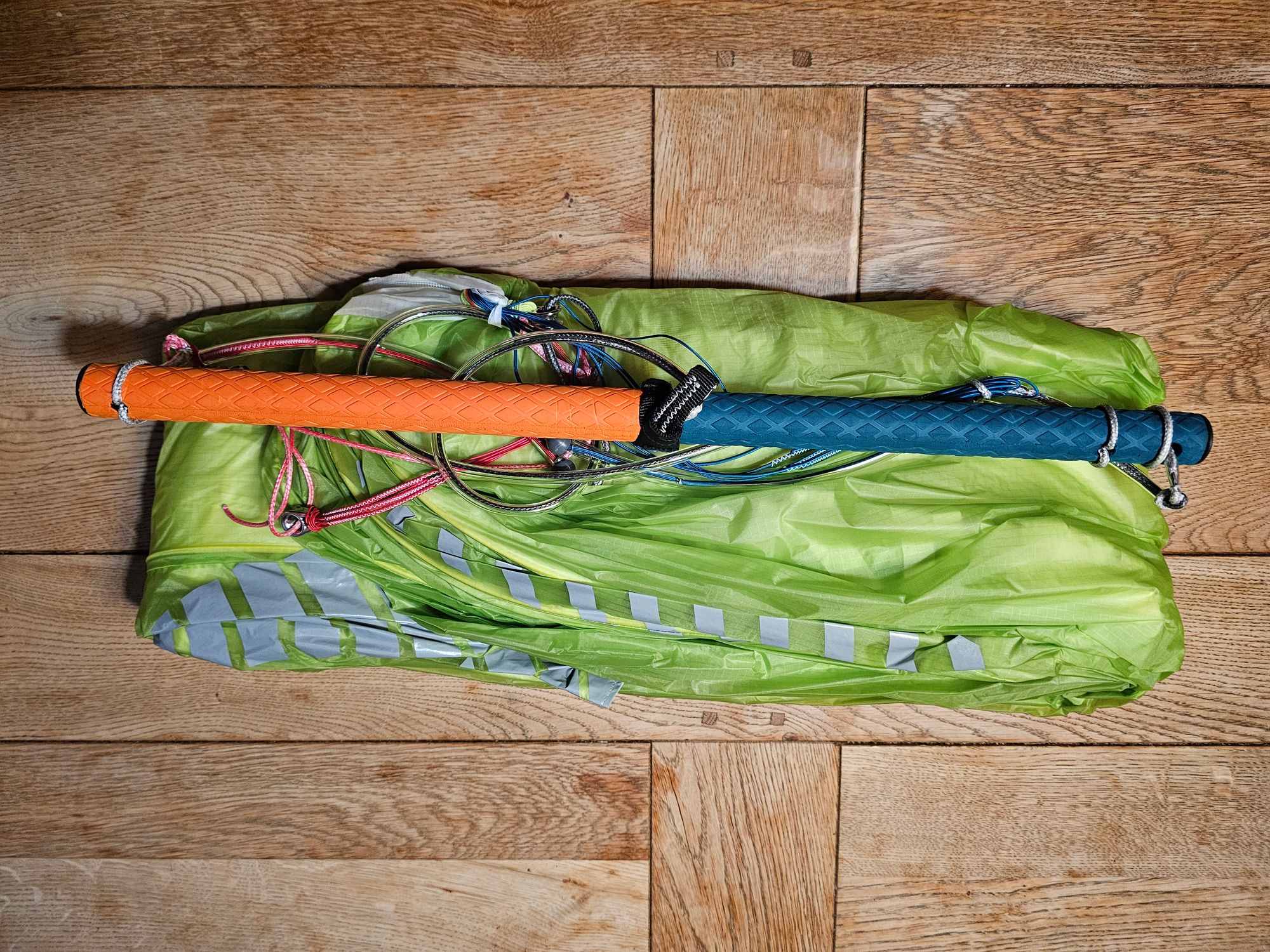I'm writing this article mostly for those considering Triple Seven's ParaTow, or possibly any double-skin RAM-air parawings appearing, and at the same time have not yet learnt to parawing. If you already manage parawinging, and feel a strong need for speed in long upwind runs, or for some reason just want to freeride without much downwinding, you may still find parts of my article helpful.
As you probably know already, parawinging is definitely not easy to get into for any of us merely average guys, even if we should think we have pretty relevant background. I have been winging a few years, all sorts of kiting for long, doing various foiling activities like dockstart, SUP, and currently learning downwinding with paddle.
A quick summary before proceeding with lots of details.
By now I think the PT does not help you in getting started with parawinging, compared to the more or less trashbag-style single-skins. It's quite the opposite for most locations and conditions. Make no mistake, you get distinct downsides from the performance you potentially can get with the PT. It's is a lot more to consider, than just the obvious differences in packability compared to single-skins.
I've had the ParaTow 4.2m since 777 started shipping 10 weeks ago. Wind season here gradually starts these days. Unfortunately, I have not been able to get more than 3 sessions on snow, in which one was very helpful to prepare for water. Then 6 sessions with a DW-SUP, only 3 of them with progression to mention.
In some aspects I'm very slowly progressing. I have realized stagnation in other areas. I need to change things if I want to learn parawinging before the autumn is bringing the good waves:
Due to the local conditions I simply need to buy a single-skin to progress.
If I'd had near laboratory-quality stable and strong wind a lot of days days, it is likely that I would continue the learning phase with the PT.
I'm not selling the PT, it was great for certain snow conditions in the mountains (may even get the 5.7 or 8 for that purpose), and I may choose to return to the PT on water after progressing.

The 777-site has gradually been filled with a lot of helpful info. But still not nearly enough to approach this occasionally flying jellyfish in an efficient way. While sounding honest and well meaning, I think their info is not giving the right picture of this product's narrow purpose. Too much "you can do all". To make things worse, it is not entirely clear what it's speciality really is, and which group of users it is targeting. I think 777 meant to give great upwind for all.
I'll get back to the good things I have found with the PT. Things that will just feel better, when or if I'm getting better.
But now lets bring the bad news. These are "extras", trouble that I'm pretty sure you don't have, anywhere near this degree, with a single-skin:
- Unbalanced, and very sensitive to wind stability when not at speed
- Demanding steering and stabilizing technique
- Waste of time trying to learn in less than 10 m/s (20 knots)
- Wetness really complicates flying
- Pulley-bar complicates further
- Multiply the above
At good speed fully inflated I think the PT is basically quite more stable than single-skins (merely based on comments and videos of single-skins). But the PT's constant urge of quickly heading down, also at speed, will probably need quite a bit of your attention for a long time. You need to constantly counteract, specially if you are holding the PT at 45°, which is doable and efficient for upwind. This thing is nowhere as friendly as a kite.
With little or no apparent wind you rely on very stable wind. Or lots of active steering for stabilizing, including big banking movements with your arm. The 4.2m has quite high aspect, and you need to counteract a downward movement from 12-position, surprisingly early. Otherwise the PT's side gets too close to ground/water, enters more turbulent/slower wind, and folds inward.
Then add water. The second, third and so on time you go out, you build up a distinct uneasiness I think must be like bringing your stamp collection foiling. My 4.2m weigh 999 grams with bar and lines. The already heavy masses of canvas gets heavier and the PT sits further back in the wind window. Then you have even less time and power to counteract the fast downward shooting to the sides.
You can with some practice manage even a little off-center wetness, in near lab-quality stable wind. It now works ok for me, pulling it up after a brief touch, if wind is strong and stable enough at the time. But I'm not sure I'd ever get comfortable enough with the PT, to call any wetness negligible.
And it easily gets much worse. If the PT rotates and folds its tips into the water, which it very easily does for a newbie when already wet, it quickly drags water in. I have only once managed to do the draining procedure sitting on my board, and it took around four minutes. Beware that the marketed idea of "..remaining afloat for an extended period", is more like one, max two seconds, if the PT touches with intakes or the outlet against water. Or more likely, as I did, and now do a bit less, accidentally submerge inlets/oulet just a little when grabbing the PT quickly from water. Beware, getting lots of water inside takes 10-15 minutes of ground flying in 8-10m/s to only have small droplets left inside, anything else will clearly be felt.
A significant number of you guys reading this will have a huge beach playground with a stable, strong sideshore wind on a lot of days. Not as when you are thinking while winging or kiting, "Oh, this wind sure is stable today" (well you should, not only complaint) I mean, it has to be stable stable.
In that case you can fly the PT while entering water, and learn restarting etc out there. I went to a such distant location, had one good session and thought such conditions may speed up learning a bit.
My local coastline is different. High and low rocks, spots with sand or other acceptable entry at few places. Often 50m to swim or paddle before steady and stronger wind.
So I pack the PT between the tighs, sitting on knee paddling out, for now using a plus-volume DW-board that buy me some extra time in standing up with this unruly thing over my head, easier setting and retrieving of the PT, and also keeps the PT a bit less wet on the way out.
Still, if the wind is not stable enough (while still being newbie), I drowned the PT and had to to go ashore several times. (You really don't want to loose you exit and walk onto rocks etc also balancing with that by now very heavy RAM-water device)
But there's a workaround, that I warmly recommend for your first period, before actually downwinding.
As the PT is set up when you receive it, it has a huge vent with coarse mesh on the underside of the leading edge, stretching almost from end to end. That's for faster squeezing out the inflation air when grabbing the PT.
Between the prototype and the first shipment, 777 surprised us with adding hook and loop fasteners outside this full width dumping vent, and stuffed optional "freeride covers" in the bag's inner pocket. I thought that was a bad idea, as it complicated this already demanding product with a bit degraded aerodynamics, alittle weight, and most of all smoothness against line tangling.
When installed the freeride covers makes the PT even less smooth against tangling, but I'm not sure if it bother aerodynamics much. I tested fitting all three covers on snow once , and it does get more inflated and gave a bit more stable ride at higher speed. Getting air out seemed to take forever though.
Consider installing the two side covers (that is 2/3-length) for learning, especially if you want a second and third chance of launching in unstable wind near shore etc.
I only did for the last session, and it does help a lot. Turned out like it looked, it's the sides that quickly swallow water, not the center. I had to take the PT down when getting back and close to the shore, with little and turbulent wind, happy to see that deflation didn't take much more time than with no covers.
But it seemed like inflation took a bit longer time with two covers. I will have to watch that some more. Anyway, I think anybody should start with side covers, to mitigate other annoyances while learning with this parawing.
You should really know about the weird steering technique that is required with the PT, that you likely also should apply with any other RAM-air parawing.
The 777 manual explains the steering fairly well, but I'll try add some clarity and refinements so you see the gravity of this, which you may decide you don't like.
Do steering by 1) banking the glider, that is starting to move your hand(s) in parallell to the opposite of the side you want to fly the glider to, then 2) make a yaw movement (twist wrist) starting to turn the near side of the bar to the new flying side. I have experimented a lot while just standing with the PT, and at speed. The banking can be done very quickly, the yaw should be slower and gradually. Never yaw first. You can make the yaw at the same time as the banking, but I'd say it is better to hold back a microsecond after the banking movement is started, to quicker build the correct muscle memory.
And remember to counteract the steering movement to stop the falling movement of the glider, just like with your ride on two wheels.
The 777 guys firmly believe you will find the PT shining once you learn this fully.
Let's say steering in this context is defined by intentionally trying to change riding direction. Banking, yaw, fall over, then counter-banking, counter-yaw.
In stable wind you can skip the banking movement and just make a tiny yaw, then counter yaw, for minor stabilization.
But (btw congrats for reading so far) there's a huge ugly gap between these two handling techniques. Handling wind gusts, not even big ones, definitely seems to require the banking version. I have challenged 777 on that one, and they do not disagree. Maybe you will be less bothered with time. But I think you always will need to to a little banking even for relatively small gusts.
Forget hooking in to a harness if you have even just moderately unstable wind, you won't have enough room for the big banking movements. (the harness line is great though, otherwise very well balanced, used it a lot on snow)
Avoid unstable wind at all costs. Flying the PT would take all your attention. And I guess, feel a bit like riding a motorcycle by standing next to it on a skateboard.
Just think of it, a tiny shift in wind direction yields a lot more change in sideways angle, with lines so much shorter than those of a kite. 777 told me, "less banking with single-skins". When I mention banking to others now trying to start with single-skins, they have no idea what I'm talking about.
I asked a couple of paragliding buddies, saying "Oh, we do banking but only for the biggest moves, not for simple turns". That had me thinking, what if the less direct contact pulley system contributes significantly to the need for banking movement, needed even for the wind gust corrections?
..And now, we are interrupting with some unofficial news from Triple Seven:
- PT-owners will receive an alternate fixed bar/line-setup for easy direct steering, internal testing says it alters the PT a lot.
- The upcoming single-skin, seen on the home page, is said to handle "very nicely".
- There will be a race version.
- The 777 guys hopes to do the announcements next week, with details.
Nothing was said about a PT v1.1, but my guess is that new buyers receive it with fixed bar only, and maybe a smaller freeride cover/outlet.
While only the race version gets the SC/pulley-system, and without dump vent.
The PT-release was a mess. I think they know, and try to fix.
I did the lengthy crazy initial line rebuild instructions, was later sent a rebuild kit that should do the same. Recently they admitted that the kit was a tiny bit better.
Groan. Ok, will wait for the fixed bar kit. My feeling is that it will help, but at the same time it does not make the PT nearly as easy to handle as a single skin.
A note about the rebuild, that was. I had the opportunity to test the PT with some fast riding on snow under very similar conditions, before and after the rebuild. The PT was generally sitting noticeably further back in the wind window afterwards. Hence the better "self centering" they claimed. But I felt the upwind was slightly compromised, although they claimed not. Slightly lowered top speed. For instance, going down a sleek hill where the wind came up, had the PT finally flutter a bit and turn down to the ground, at a little lower angle and speed than before.
It is by no means bad now, and I'd be surprised if any single-skin were anywhere near the PT in upwind/speed performance. My guess is that the upcoming race version will have the PT's initial tuning. Then, guessing again, during the two weeks of PT delivery this turned out to be be just too much for the market, expecting (like me) a bit more omni-potent product.
The PT has outstanding build quality with very good materials. The price was not wrong. They could still have had more patient buyers if they initially used a intro price like another paragliding company did with their parawing. Instead, 777 now has a substantial "summer discount", so my recent feedback for them was:
Double discount for current PT-owners, buying their soon coming single-skin.
It's not so much about the money, I just would like to see them straighten things and give my trust fully.
I'm sure there are other newbie PT-owners that gladly would buy another parawing at a fair price, to speed up learning, and maybe return to the PT later.
I understand that a good single-skin will fly ok in a bit less wind, not needing this crazy attention if it's a little gusty. Then I could progress conveniently at my home spot.
Still want the PT for learning? Take the 3m!!
When I have enough wind to handle the PT (as a beginner), the 4.2m takes me up foiling with a DW-board and a medium big frontwing, usually without foot pumping at all. (btw the PT can't really be pumped) So my guess is that with a 3m you can make use the same days, and save the amount of lines and canvas - somthing we certainly would appreciate.




Still reading?
My five cents; don't write off the race versions.
Randonee competitions have been very popular in Europe lately. The combo of up- and downhill skiing is also loved by spectators.
I can (faintly) see that parawinging can be this equivalent on water, upwind and downwind. Where I live, it could also be super spectator-friendly.
But the fastest parawings first need to evolve I think.